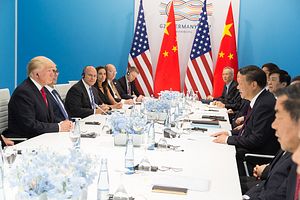The trade spat between China and the United States is heating up, with tit-for-tat tariffs. Carlos Gutierrez, former U.S. commerce secretary under George W. Bush and current co-chair of the consulting firm Albright Stonebridge Group, told Bloomberg that “Wars start with battles, and the battles have started.” Chinese President Xi Jinping “can’t afford to look like he’s getting pushed around,” he added.
To some degree, Gutierrez is right considering the latest development.
On April 3, the Office of the U.S. Trade Representative (USTR) announced that it has proposed imposing 25 percent tariffs on approximately $50 billion worth of Chinese imports, as “part of the U.S. response to China’s unfair trade practices related to the forced transfer of U.S. technology and intellectual property.”
The USTR also published a proposed list of Chinese products that could be subject to additional tariffs, targeting about 1,300 separate tariff lines ranging from aerospace technology, machinery, robotics, and medical instruments to the information and communication industries.
In its statement, the USTR made it clear that it particularly picked the products that “benefit from China’s industrial plans” such as “Made in China 2025.” The USTR argued that, in order to seize economic leadership in advanced technology, China has been bolstering these industries by coercing “American companies into transferring their technology and intellectual property to domestic Chinese enterprises.”
Within hours, China responded that it will retaliate.
The Chinese Embassy in the United States quickly published a statement on its website, saying that the United States’ “unilateralistic and protectionist action has gravely violated fundamental principles and values of the WTO.” Quoting a Chinese saying that “it is only polite to reciprocate,” the embassy vowed that China will “take corresponding measures of equal scale and strength against U.S. products in accordance with Chinese law.”
Soon, the Chinese Foreign Ministry published a longer statement, harshly blaming the United States for turning “a deaf ear to the voices of the business communities” and ignoring “the interests of consumers from the two sides.”
“We will take proportionate measures of the same intensity and scale on U.S. products. These measures will be announced soon,” ministry spokesperson Lu Kang said in the statement. “We have the confidence and capability to counter any measure of trade protectionism taken by the United States.”
In line with China’s Foreign Ministry, China’s Commerce Ministry also issued a strongly worded statement in Chinese, condemning the United States for harming not only mutual interests but the global economy.
Despite the tit-for-tat finger-pointing from both sides, the chance of resolving these trade “battles” before they esclate into a war is still high.
On the U.S. side, the USTR’s latest proposal will not take effect immediately. The U.S. government still needs to hold hearings on the tariffs and the public will be given time to provide feedback. The whole process will last nearly 60 days, according to U.S. Trade Representative Robert Lighthizer. The period can provide both countries time to negotiate.
On the Chinese side, Beijing can afford to and in fact is ready to compromise on trade. In this regard, Gutierrez might be wrong about President Xi. Multiple top Chinese officials — including Xi himself — have repeatedly emphasized that Beijing doesn’t want to have a trade war with Washington.
Chinese Premier Li Keqiang, for example, pledged that China will ease access for American businesses and accelerate market opening to avoid a trade war during the press conference amid China’s “Two Sessions” in mid-March.
Thus, the current noisy spat might only be a bargaining tactic for both sides: the louder one side shouts now, the more benefit it will get later at the negotiation table.

































